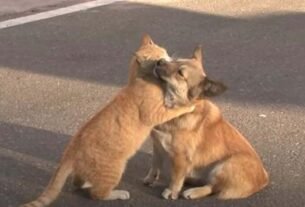Cats are complex creatures, and even lifelong cat lovers can sometimes misinterpret their signals. Unless you’ve lived with a cat for a long time, it’s easy to misunderstand what a cat’s body language is truly communicating.
For those who rescue cats, understanding their unique body language is crucial. It can mean the difference between recognizing a stray former house cat who is open to being petted and identifying a cat who only seems to be open but is actually feeling fearful inside.

Two Unexpected Cat Fear Responses
Cat advocate and educator Stephanie Merlin shares insightful posts aimed at improving the well-being of cats and the humans who care for them.
“Cats deserve more than just food and shelter. They have rich emotional lives we need to honor. 🤲❤️” says Merlin.
In a post about cat fear responses, she explains why things may not always be as they seem.
“🐾 It’s important to highlight the subtle nuances of cat behavior. Let’s talk about recognizing cat fear responses, often mistaken as acceptance. Understanding their body language, fear, anxiety, and stress cues is key. 🐱💬” shared The Fulfilled Feline.

We’ve all heard of “fight or flight,” the automatic primal fear response to a stressful and scary event. But as Merlin points out, a cat may have other, lesser-known fear responses.

Freeze Fear Responses
When a cat finds itself in a frightening situation, like at a shelter, a vet’s office, or in a TNR (trap-neuter-return) trap, it might freeze in place. In a humane trap or carrier, freezing can become the only option.
When a cat freezes, someone might mistake this as the cat being comfortable or open to being petted. However, in reality, touch is unwelcome and could increase the cat’s stress.
On the other hand, if your companion cat freezes at the vet’s office, your familiar touch and soothing words may provide comfort. In this case, it’s the vet’s office that’s scary, not your touch. Of course, the vet’s touch is another story, but it’s necessary for a little while.


Fidgeting Fear Responses
Just as people may fidget when they’re anxious, cats might also display similar behaviors when scared. They may sniff around, groom themselves excessively, or smack their lips.

If a cat is fidgety, it might not appear scared, but it’s a coping mechanism. As someone pointed out, even purring can be an easily misinterpreted coping mechanism. Like the cat frozen in place with fear, a fidgety cat often just wants its space.

Simple Ways to Help a Cat with Fear Responses
How can you help a cat exhibiting these fear responses? First, it’s crucial to be aware of the subtle cues in their body language.

Helping cats with fear responses can include simple actions such as:
- Avoid making eye contact, which can be seen as threatening.
- Focus on having a calming, loving voice and positive energy.
- Be as non-threatening and respectful as possible.
- Give the cat space and avoid trying to pet them.
- Be supportive without any expectations.
- Allow the cat to choose how they want to interact.
- Listen with your intuition and heart to what the cat may be feeling inside (empathy).
Lastly, it’s important to note that cats rescued through TNR are usually feral. As such, they may never want to be touched by a human—and that’s perfectly okay! Although we might wish to cuddle them all, the best reward is releasing them back to their familiar territory after they’ve been spayed, neutered, and vaccinated.

You can find more insights at The Fulfilled Feline on Instagram and Facebook. Merlin also offers a Behavioral and Emotional Wellbeing Resource Bundle to help cultivate emotional awareness for your cat.
Featured image via Facebook/Cat Man Chris



